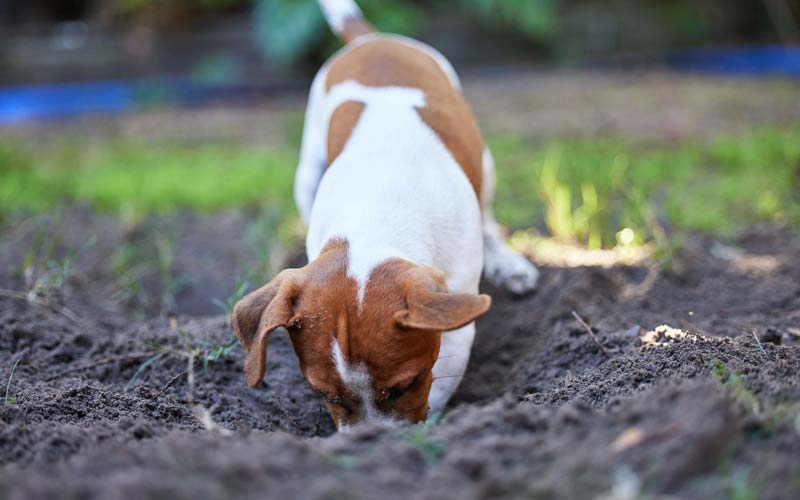Have you ever stepped into your yard, only to find it peppered with freshly dug holes? While this behavior can be frustrating, digging is a natural instinct for dogs, rooted in their history as hunters and den builders. From cooling off in the summer to chasing unseen prey, dogs dig for a variety of reasons that may not always be obvious to their owners.

Understanding why your dog digs is the first step to managing the behavior. Whether it’s driven by boredom, anxiety, or simple curiosity, addressing the root cause can save your yard and improve your pet’s well-being. This article explores the most common reasons behind canine digging and provides actionable strategies to help curb this habit while keeping your furry friend happy and healthy.
1. Why Do Dogs Dig?
Digging is a behavior deeply ingrained in dogs, driven by natural instincts, emotional triggers, and environmental factors. Understanding these motivations can help pet owners address the issue effectively.
Natural Instincts
Digging traces back to dogs’ wild ancestors, who relied on the behavior for survival. Wolves and wild dogs often dug dens for shelter, safety, and raising their young. This instinct remains strong in modern dogs, particularly in breeds like terriers, huskies, and dachshunds, which were historically bred for tasks involving digging, such as hunting burrowing animals or navigating snowy terrains.
Emotional Triggers
- Boredom: Dogs with excess energy or insufficient stimulation often turn to digging as a form of entertainment. This behavior is common in active breeds that require frequent physical and mental engagement.
- Anxiety: Separation anxiety or stress caused by loud noises or unfamiliar environments can lead dogs to dig as a coping mechanism, often around fences or doors in an escape attempt.
Environmental Factors
- Comfort: Dogs may dig to regulate their body temperature. On hot days, they seek cooler soil, while in colder weather, they create insulated areas to stay warm.
- Curiosity: A dog’s keen sense of smell and hearing often detects small animals or scents buried in the ground. Digging becomes a way to explore these stimuli.
By identifying the underlying reasons for digging—whether rooted in instinct, emotions, or environmental needs—owners can take targeted steps to manage the behavior while ensuring their dog’s physical and emotional well-being.

2. The Impact of Digging
While digging is natural for dogs, its effects can cause frustration for owners and potential harm to the dogs themselves. Understanding these impacts is key to addressing the behavior effectively.
Damage to Lawns, Gardens, and Property
A dog’s digging can quickly ruin a carefully maintained yard. Lawns are left pockmarked with holes, and flower beds or vegetable gardens may be destroyed. Beyond aesthetics, damaged irrigation systems, uprooted plants, and disturbed landscaping can lead to costly repairs.
Potential Hazards for Dogs
Digging isn’t without risks for the dog either. Unearthing sharp objects, such as buried glass or metal, can cause injuries. Soil treated with fertilizers, pesticides, or other chemicals can be toxic if ingested or come into contact with a dog’s skin. Additionally, unintentional encounters with underground wiring or pipes could pose electrical or physical dangers.
Strained Relationships Between Dogs and Owners
Persistent digging can test the patience of even the most devoted dog owners. The frustration of seeing a backyard repeatedly destroyed or feeling powerless to stop the behavior can lead to resentment. Over time, this strain may weaken the bond between owner and pet if the issue is not addressed compassionately.
By recognizing these challenges, owners can take proactive steps to mitigate the effects of digging, ensuring both their property and their relationship with their dog remain intact.

3. How to Address Digging Behavior
Addressing a dog’s digging requires understanding the root cause and applying targeted solutions. By combining observation, prevention, and alternative outlets, owners can curb this behavior while ensuring their pet’s well-being.
1. Identify the Cause
Understanding why your dog digs is the foundation of effective management:
- Observe Behavior and Environment: Pay attention to when and where your dog digs. Are they drawn to specific areas, such as shady spots or near fences?
- Tailor Solutions to Triggers: If boredom drives the digging, increase stimulation. For anxiety-related digging, consider calming techniques or addressing separation stress.
2. Provide Alternatives
Redirecting the behavior can satisfy your dog’s instinct without causing destruction:
- Designate a Digging Area: Create a sandbox or digging pit where your dog is free to dig. Encourage use by burying toys or treats in this area.
- Engage with Toys: Use puzzle feeders, chew toys, or interactive games to occupy your dog’s attention and energy.
3. Modify the Environment
Prevent access to areas you want to protect while making your yard dog-friendly:
- Barriers and Deterrents: Use fencing or natural deterrents like citrus peels to keep dogs away from gardens or flower beds.
- Comfortable Spaces: Provide shaded areas during hot weather or warm bedding during colder months to reduce digging for temperature regulation.
4. Increase Stimulation
A tired dog is less likely to dig out of boredom:
- Exercise Routines: Daily walks, runs, or playtime can help expend energy.
- Interactive Activities: Play fetch, train new tricks, or explore agility exercises to keep your dog mentally and physically engaged.
5. Address Emotional Needs
Support your dog’s emotional health to reduce anxiety-driven digging:
- Gradual Training: Desensitize your dog to being alone by gradually increasing the time they spend separated from you.
- Consistent Routines: Establish a predictable schedule for meals, walks, and playtime to help your dog feel secure.
6. Safety Tips
Protect your dog from harm while managing digging behavior:
- Remove Hazards: Clear your yard of sharp objects, toxic plants, or harmful chemicals that could be unearthed.
- Non-Toxic Deterrents: Use safe deterrents like motion-activated sprinklers or specialized sprays to discourage digging in unwanted areas.
By combining observation, prevention, and redirection, owners can address their dog’s digging behavior effectively while fostering a happier, healthier environment for their pet.

Conclusion
Digging is a natural behavior for dogs, rooted in their instincts, emotions, and environment. While it may frustrate owners, understanding why dogs dig is the key to managing this habit effectively. Whether it stems from boredom, anxiety, or curiosity, there are practical solutions to address each trigger, such as providing alternative digging areas, increasing stimulation, and modifying the environment.
By identifying the cause and implementing these strategies, you can protect your yard and foster a stronger bond with your furry companion. Remember, patience and consistency are essential as your dog learns new behaviors. Take the first step today by observing your dog’s digging habits and trying one of the solutions discussed here. With time and effort, you’ll create a happier environment for both you and your pet.